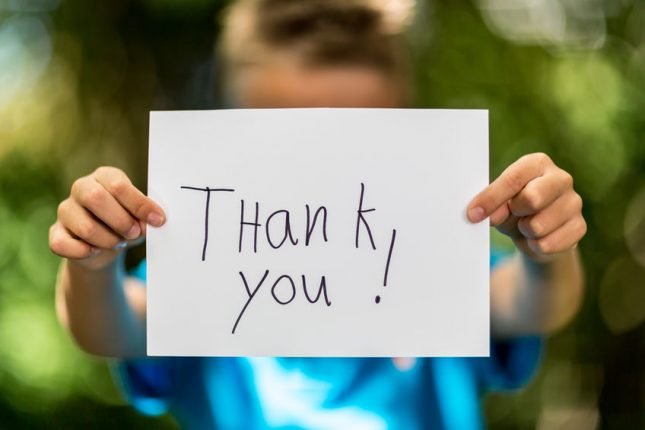Sometimes, when I give a seminar that involves teaching our children to do as they are told, a question comes up early on. I have just got as far as saying, “You approach your child with a simple request…say “Pick up the blocks” – or – “Come and give me a hand with the dishes” ”…and an audience member’s hand shoots into the air.
“Should you say “Please?”
I am about to retort, “Of course”, thinking it is perfectly obvious, when I realise that nowhere in my example, did I include the word, “Please.” No wonder I hesitate to get the reply right. Walk your talk, Diane!
So let me be unequivocal. Every request to our child should be accompanied by the word “Please” and every recognition of their accomplishing a requested task should be accompanied by the words “Thank you.” Why? Because modeling the behaviour that we expect is the best way – and the only way with integrity – of getting that behaviour.
Why are manners so important?
Manners are an outward demonstration of two important virtues – gratitude and respect. When we teach our children to have good manners, the accompanying development of the virtues of gratitude and respect is good for their emotional well-being, their social interactions and their little soul.
Manners make a person pleasant to be with as well as being an outward manifestation of self-discipline, courtesy and social skills.
Apart from all of that, it is a lot easier for several people to get through a door-way, if there is some hierarchy of manners to guide the order of proceeding, rather than jostling, elbowing and competing.
When I talk about “doorways” I always think of my beloved late step-father – a man of impeccable manners and courtesy. As a child I always gave way to him (as a grown-up) in doorways. There came that imperceptible but well-defined moment when I was in early adolescence, when he gave way to me because I was a “woman.” Needless to say, we never got jammed in a doorway!
When (and how) to start
A few weeks ago, an article appeared in our local newspaper suggesting that three was a good age to start teaching our children to say “Please” and “Thank you.” I disagree. I think that we can start two years earlier. The sooner we start, the more automatic the behaviour will be for our children.
If we teach our children the “Action” part of gratitude, the rest usually follows. Ask your high-chaired toddler to hand you his plate…”Give your plate to Mummy, please.” When he gives it to you…”Thank you for giving Mummy your plate.” When he asks you for a biscuit, model “Can I’ve a biscuit, please Mummy?” Even if he is only capable of “Peeeese” he has done well and deserves your gratitude.
If you insist on “Please” and “Thank you” every time, it should soon become automatic.
Have I left it too late?
Never. I remember car-pooling with quite an age-range of children. Some of them had lovely manners. They would hop into the car and greet me. They would exit the car and thank me. Others weren’t quite up to speed.
I developed the habit of keeping my elbow on the central locking button. The car doors simply didn’t open until the child nearest the door said, ‘Thank you for the ride.” It always amazed me that as soon as one child modelled gratitude and good manners, all the rest would follow. It was hard to tell if they developed courtesy or they just worked out the most rapid way to get away from me, but it looked like sincere good manners.
Considering the amount of time we take out of our day to ferry children to and from their activities – and hanging about in between – it seems a very small ask that they should express gratitude.
Another courtesy you could consider insisting on from your children (whatever age they are now) is that no-one leaves the table without thanking you for the meal. Don’t preach. Just say, quietly and firmly, “I would like you to thank me for the meal you have just eaten.”
I have a treasured memory of my late father-in-law. In the twenty-eight years that he was in my life – and I have no doubt the fifty-seven years he was married to my mother-in-law – he never left a meal-table without saying to his wife, “Thank you, Darling.” What a model of gratitude for his son, his grandchildren and anyone who joined them for a meal.
Insist on manners
When you insist that your child goes and thanks his host and hostess before he leaves the birthday party, he may be doing it just as a matter of social form initially but if it becomes a habit, the gratitude will follow.
When you pick up your little one from daycare, when you leave grandma’s, when you leave a friend’s place, always thank the host and get your child to say “Thank you.”
In shops, insist that they say thank you. When your child is given a gift or when grandparents arrive with a lollipop, insist that your child says thank you and don’t permit the handover to be completed until gratitude is shown.
Prayers and summaries
If your family practises a particular faith or religion, then another way of including gratitude in your children’s lives is by praying with your children every night. It gives your children the opportunity to list all the good things in their day that they are grateful for and gives them the opportunity to thank God for the people in their lives.
If you do not find prayer is appropriate, it will help promote gratitude in your family to sit on your child’s bed and help them summarize all the good things that have happened that day and the people who have made that happen. You might like to begin with, “Let’s talk about what we are grateful for.”
You may be amazed how long your child can make gratitude last, as they think up one more thing to be grateful for so they will keep you at their bedside!
Gratitude-in-training
Our delightful grandson Zack was 23 months old when Grace, six weeks younger, came over to play, clutching her beloved teddy to her chest. In a swift and elegant move, Zack swiped the bear off Grace while simultaneously saying “Please. Thank you.”
He’s got the manners down pat. I think gratitude may take a little longer!




